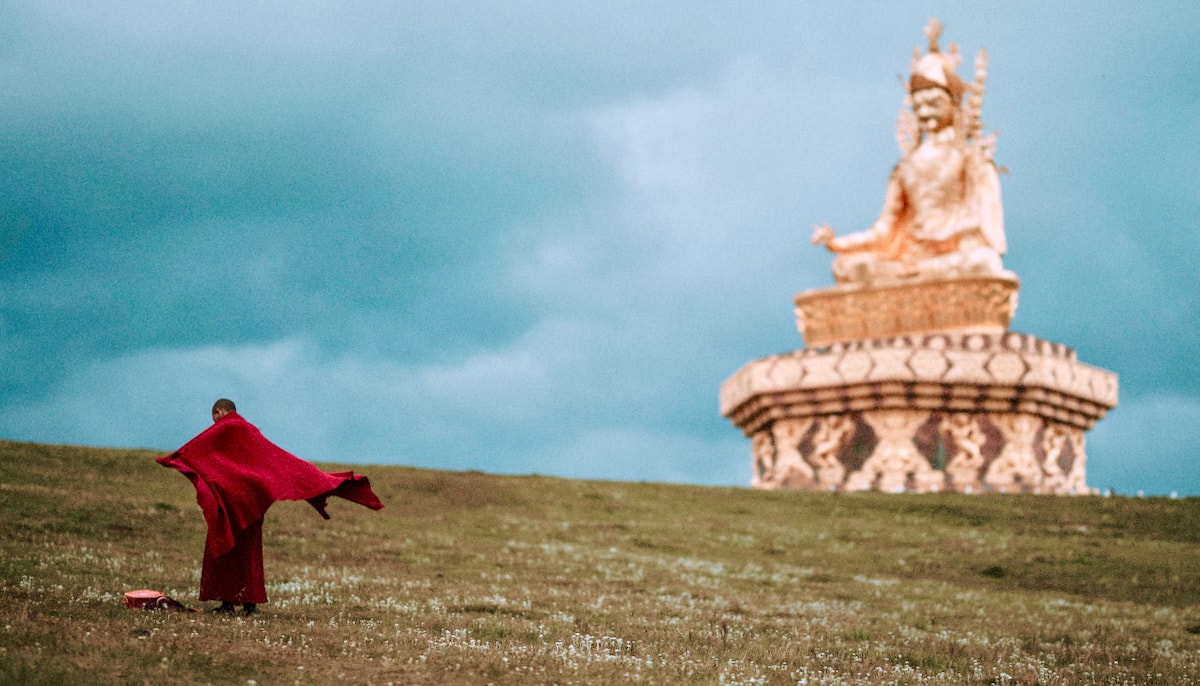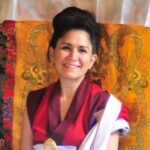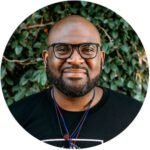A year ago, it would have been hard to imagine publishing an article with this headline. But a lot happened in a year: the #MeToo movement hit the world by storm, and shocking revelations of abuse by Buddhist teachers in high-profile communities, including Shambhala and Rigpa, became mainstream news.
While communities are still grappling with these allegations and legal issues remain to be resolved, these allegations have given rise to many questions and concerns regarding the role of the teacher in Buddhism.
In light of the most recent upheavals, we’ve chosen in this discussion to focus on the guru model in the Tibetan tradition, in which the teacher is central to the path; our panelists are deeply involved in guru practice and offer, from the inside, insights into how that teacher–student model may or may not be workable going forward. However, the conversation is relevant to any Buddhist traditions in which the teacher—whether a lama, roshi, or ajahn—holds great power. –Editors
Buddhadharma: The question at the heart of this forum is, “Is the guru model broken?” We’ll explore an actual answer to that, but first, how do you feel when you hear the question?
Lama Rigzin Drolma (Anne Klein): I’m not sure I want to tell you this, but when I heard the question, my first reaction was alarm. Like, no, it can’t be broken! Because if it’s broken, then the whole tradition is broken. Relationship is crucial to one’s practice at every level of the path, and definitely key to progress in tantra and Dzogchen.
Lobsang Rapgay: My initial reaction, too, was to say, no, it’s not broken. But I also think there’s a contextual element to it in the culture. In Tibet, the teachings are passed down from one guru to another, making the guru indispensable. However, given the vast cultural, social, and political differences between Tibet and the West, it is critical to examine whether that model is also feasible and sustainable here.
Pema Khandro Rinpoche: I feel a sense of curiosity about what the question means, because there are a lot of different models for teacher–student relationships in Tibetan Buddhism. Some are more authoritarian, some are more parental. Sometimes it’s more intellectual and teacherly. Other times, it can be more like a coach or even a spiritual friend. I’ve certainly met lots of Vajrayana practitioners who believe there is one model and one right way for this relationship to be, but in my experience, it’s tremendously diverse.
Lama Rod Owens: When I hear the word guru, I feel this heaviness in my guts—I did even before I came onto the Buddhist path. We’re transplanting a certain kind of relationship that was prevalent in another culture onto this Western paradigm, and I think we are still doing the work to unlock what the guru means for us as Westerners. I don’t know if that model is broken. The guru means different things to different people. My personal relationship with the guru is something I’ve had to come to terms with through really intense negotiations with my own projections, my own hang-ups, my own lack of understanding of what authentic relationship with another human being looked like. Maybe it’s the guru model that’s broken, or maybe it’s my own efforts that are not quite refined enough to enter into this very profound relationship.
Buddhadharma: We’ve all heard stories, especially recently, of how this model can sometimes lead to harm. What does the guru model look like when it’s not working well? How does it break down?
Lobsang Rapgay: What we see in these recent cases, in addition to issues associated with the psychological development of the teacher, is a lack of rigorous traditional training and education, as well as the absence of ethics as the foundation of their teachings. Rigorous traditional training not only provides extensive education in the theories and practices of the teachings, but also a structure and discipline for trainees to conduct themselves ethically in body, speech, and mind. All traditions repeatedly stress ethics as the foundation for all practices.
When someone without formal training assumes the role of teacher, especially in the case of esoteric teachings, the potential for abuse is enormous. At first, the teacher might personalize and simplify the teachings, making them more accessible and appealing to draw in students. But from there, the teacher is no longer beholden to the tradition; they are free to interpret and introduce the teachings in their own way, without any constraints. Such teachers rarely emphasize the centrality of ethics or subject themselves to the ethical guidelines of a Vajra master.
This lack of grounding leads to a form of personalized Buddhism of which the teacher is the sole authority. From there, you begin to see very subtle subjugations or, in extreme cases, I’ve seen people use the word “enslavement.” People are threatened; other teachers or teachings are not encouraged. Over time, you begin to see the threats, then abuse increases. Often it’s sexual, but it’s not limited to that; it’s also emotional, physical, and financial. There’s always secrecy and silence. It does not take long to create an organization entirely centered around the teacher and his or her interpretation of the teachings. The teacher has complete power and authority, and others support the teacher while maintaining secrecy and silence.
Pema Khandro Rinpoche: I feel Buddhism is taking a positive step forward. I was ashamed when people asked me how the #MeToo movement was affecting Buddhism and I couldn’t give any examples. Then, all of a sudden, people were speaking up and speaking out, and I was so proud of the communities that spoke out and of the brave people who told their stories under great duress. It’s important for us to go through this stage so that we can go beyond a naïve view of Buddhism based on fantasies of Shangri-La, where Tibetans are all perfect and teachers are all flawless, and all you have to do is turn off your intelligence and do what they tell you. That’s a natural stage when someone converts to a new religion. We know from the research that at first, people take things too literally; they can be fundamentalist. But gradually, they become more adept at interpreting the tradition themselves and looking into these complex issues and ambiguities, and they go beyond that black-and-white thinking. Culturally, as American Buddhists, I think that’s where we’re at: we’re growing up, we’re maturing. And I’m so relieved. I feel this will benefit all of our practice and Buddhism as a whole. It’s a painful stage, talking about these horrible abuses that have happened, but that’s a very important stage to be in.
Lama Rigzin Drolma: It may be different when you grow up in a Buddhist culture, but in our culture, partly because Buddhism is so new, there are many fantasies about Buddhism. People carry these into a relationship with the teacher. This often involves much self-deception and projection. Also, it’s often said that whereas Tibetan culture really values loyalty, Western culture values independence, including the idea that I should be able to do whatever I want. So a person might find it difficult to listen to or respect a teacher who isn’t inclined to encourage them to do exactly what they want; they might not understand that part of the path means, in fact, getting over that notion of freedom.
Buddhadharma: What are the solutions? How do we make it work?
Pema Khandro Rinpoche: Well, it’s true, we’re not in a Buddhist culture. So it’s even more important that our education as Buddhists has to include multiple sources of authority. Students need to be well versed in various texts; they need to see other teachers and teachings; they need to know about Buddhist philosophy and vows. And teachers need to teach students the controversies within Buddhism rather than just giving a direct teaching from their own lineage. They need to show the students that there are opposing views—that enhances a student’s sense that it’s okay to have doubts and interrogate these really great big questions that Buddhism posits for us. If they know that Buddhism has a long history of debate and vigorous discourse about everything that matters, then that will help students to go beyond fundamentalism and see a situation from multiple points of view. Also, in my sangha, it’s a rule that if you’re my student, you have to have something else in your life besides Buddhism. You need to have family connections, or a hobby, or something else; otherwise, what’s going to happen if that relationship with the teacher breaks down? I often train students of other lamas, and I don’t know who they’re going to end up with. It may be with a Sogyal Lakar, so I want to know that student has had practice in raising doubts, asking questions, and disagreeing with me. I love Buddhism so much, but if there’s something misogynous, I call it out and I say, “I don’t feel comfortable with this. I don’t know about this. Where do you think this is coming from?” It’s something we practice, so when they go out and train with other teachers, they know how to respectfully dialogue. Culturally, I think that capacity for respectful disagreement is something we lack.
The steep hierarchy isn’t always the same. The teacher also has teachers, and in those relationships, the teacher isn’t the guru—the teacher is a student. So the teacher is not a state of being but a role one plays in a particular context.
—Pema Khandro Rinpoche
Lama Rigzin Drolma: Without that agency, we find a kind of blind trust in the kindness of the teacher. Trust is absolutely crucial, but sometimes the idealization gets so strong that the students aren’t even concerned with whether they’re actually being seen or whether there’s actual kindness. The teacher just becomes a super-idealized being. That being doesn’t exist. The teacher may in fact be a narcissist. He or she might order students around, or abuse them, and that may be accepted by the student because at least it’s some form of contact. So the student may have a certain psychological disposition, which the teacher then takes advantage of, consciously or unconsciously. But honestly, given the cases we’ve been reading about, it’s hard to see how it could be unconscious.
Lama Rod Owens: In conversations with communities, what I find, over and over again, is a lack of willingness to confront power, to talk about power, or to have any education around power. That leads to some of the situations we find ourselves in, particularly when we’re talking about the most vulnerable folks in our sanghas. There is a way in which the sangha itself—not the teacher, but the sangha itself—conspires to force individual members to fall into line to support teachers or support policies that are unhealthy. Some of what we’re seeing is the manifestation of cult cultures within our Buddhist communities.
Pema Khandro Rinpoche: Another thing we’re seeing is a major lack of education for some of these traditionally trained teachers around sexuality and gender equality. One of the things that horrified me about these stories we’ve seen is teachers who not only damage people but also think it’s okay. They don’t know it’s not okay to treat women like this. These teachers need to understand that there isn’t consent when the power differential is so great, and also that marginalized people who are still developing their agency may not even be able to give consent yet. So it’s the teacher’s job and responsibility to look out for students and to be aware that the students are much more vulnerable in those relationships.
I don’t know if a teacher can fully develop if they don’t have peers. One of the problems we see with Tibetan Buddhism in exile is that teachers don’t have other teachers around them. They are at the top of the pyramid, the top of a very steep hierarchy, and that’s dangerous. I can say for myself, as a teacher, that’s a very isolating place to be. I would not want to be in that situation, where there are no peers to dialogue with me.
Lama Rod Owens: The conversation we’re unwilling to have on a national level is that some of the teachers we love and admire and follow aren’t actually ready to be teachers yet; there’s a level of emotional immaturity that puts many people at risk. I want there to be more accountability within sanghas, but I also want us, as teachers, as advanced practitioners, to hold each other more accountable. And I want sanghas themselves to have more accountability structures, so we’re helping sangha members support each other. If their relationship to the primary teacher is something that they’re unsure about, there should be an open, honest dialogue about what’s happening. This kind of supported and transparent sangha culture is the antithesis of how certain sanghas and teachers maintain power and hierarchy.
Buddhadharma: In his book Turning Confusion into Clarity, Mingyur Rinpoche says, “The guru is both the most important and the most misunderstood aspect of Vajrayana.” What are some of the common misconceptions about the role of the guru?
Lama Rigzin Drolma: The guru–student relationship is meant to be about opening up to the possibility of awakening; I think that’s not always understood. It’s also complicated because, in order to ripen, we do need different aspects of relationship. For example, many of us need our teacher to function in a way that our parents didn’t, to see us in ways that our own parents didn’t see us. That can be an important part of growth.
The principle of seeing your teacher as the Buddha is critical, but it also comes with the problem of idealization. This is where a lot of people get stuck. People get very excited. I have done this too, and there is a joy and inspiration in it, but it also very easily hardens into a view that the teacher is up there and really amazing and totally different from me.
In our culture, there are many fantasies about Buddhism, and people carry these into a relationship with the teacher. This often involves self-deception and projection.
—Lama Rigzin Drolma
I took up the practice of seeing my teacher as a buddha, but at the same time, he was also shouting at people and scolding people—especially me—telling us, “You’re cutting the vegetables wrong!” So on the one hand, you’re seeing one aspect in which everything is really pure, and you’re taking in all of that, but on the other hand you realize these are also human beings and there are smells and garbage. That’s challenging for people, but for me, it was very helpful to realize that I could feel my teacher was a buddha and also take in his appearing completely ordinary, chopping vegetables, appearance and emptiness together.
Lobsang Rapgay: The whole concept of the guru comes from the Vedic tradition, which was later incorporated into Mahayana Buddhism, particularly Tibetan Buddhism. Historically, the Buddha didn’t create a lineage of teachers by delegating responsibility to any one disciple; rather, he passed the responsibility to the sangha, the community of monks. He told them that after he has passed, they should turn to the teachings to guide them. Thus we find that in early Buddhism, the teacher was regarded as a kalyanamitra, or spiritual friend—someone who works with you to understand the teachings and helps you process and integrate them, much like a doctor uses medicine to treat a sick patient. In the Mahayana tradition, however, Tsongkapa describes the teacher as someone who is indispensable, which echoes the concept of the guru in the Vajrayana tradition. In the Vajrayana tradition, the guru is to be seen literally as a buddha, someone whose authority is unquestionable.
The question is this: in the twenty-first century, can we see someone as the embodiment of the Buddha, or is it better to regard him as a spiritual friend? Having to see one’s teacher as a buddha, particularly when the idea is so foreign, imposes an enormous burden on Western students. How does the student emotionally reconcile the need to regard the teacher as a perfect authority with the fact that the teacher is a human being, with evident human fallibilities? This has led to difficulty, both psychologically and culturally, in making a distinction. It’s not helped by individual teachers who may then consciously or unconsciously manipulate vulnerable students into believing that whatever they say or do should be seen as the activity of a buddha.
Pema Khandro Rinpoche: In the Nyingma tradition, they talk about different hierarchical positions. In outer tantra, it’s really quite steep. It’s like relating to this sacred deity that’s far away, far above oneself, and you’re sort of groveling at their feet. But when you get to the inner tantras, then you’re not just doing guru yoga and visualizing the guru as a buddha, you’re getting transmission from that buddha and becoming that buddha yourself. That hierarchy is collapsible and we practice that collapse in the meditation. So there is this dialectic going on between the teacher that’s outward and the teacher that’s inward.
I think a big misconception is that the steep hierarchy is always the same. The teacher also has teachers, and in those relationships, the teacher isn’t the guru—the teacher is a student. So the teacher is not a state of being but a role one plays in a particular context.
Lama Rod Owens: I’m very sensitive to how we manipulate relationships to fulfill our unmet needs. And I have seen this over and over again in terms of the student–teacher relationship: the teacher becomes what we need. At that moment, when we manipulate the teacher into this position, we lose the profundity, the specialness, the particularity of the relationship.
I was very fortunate, and am still very fortunate, to be in relationships with teachers who are so mature that they actually cut through those projections. They do not allow those unconscious projections to manipulate them into a position that does not ultimately serve the student. But I think that as a culture, we haven’t yet achieved the maturity to hold these very profound and subtle kinds of relationships. We’re doing the work, but we still have a ways to go to understand how we’re unconsciously projecting unmet needs onto our teachers.
Buddhadharma: Could you describe what the guru–student relationship looks like when it’s working well?
Lobsang Rapgay: I think a good relationship is when you, as someone who is seeking the teachings through the help of your guru, feel safe and that you can depend on and turn to the guru when you are in distress. You can turn to him. And he has the ability to make you feel like you are an individual. I remember my root guru—that’s how he made me feel. Even though I wanted to do something against his wishes, he would listen to me and he would hear me, and I felt like he was somebody I could open up to without any fear. I saw how he treated everyone in a very human, kind way regardless of their status. When I received a teaching from him, I felt I was receiving it from somebody who embodied it. That kind of inspiration has a profound effect. Though I was a simple young monk, he treated me as a person. When we talk about a relationship between a guru and student, sometimes, particularly in the West, we romanticize it, making it more mystical than it needs to be. But I think, in the end, that all relationships are enormously challenging; they all require a level of emotional and psychological maturity. Our ability to maintain healthy relationships with people close to us must necessarily be the basis for developing a mature, meaningful relationship with a spiritual teacher.
Buddhadharma: What are some of the factors that make the teacher–student dynamic successful?
Pema Khandro Rinpoche: As a student, it’s important to have a teacher who’s the right fit. There are different types of teachers. Some are more wrathful, some are more sweet, and some are a combination. If someone is coming with a lot of trauma around being corrected harshly, the student might not be able to make use of those kinds of instructions. Someone else might really benefit from a stronger hand. Either way, the motivation for the relationship has to be the enlightenment of both the teacher and the disciple; there has to be a sense of mutually progressing, mutually awakening.
I think students need to bring more confidence to these relationships. They have to be willing to make mistakes and do it wrong and be corrected. If someone doesn’t have enough confidence, then it can be traumatic to fail or not do it right. They need the confidence to show up with the questions they have, the doubts they have, the flaws. Because how can the teacher help if the student is just trying to show up as a perfect student? Wanting to win the teacher’s love creates this incredible complication.
Finally, the teacher needs to know about gender equality. The teacher–student relationship cannot work in the modern age unless teachers are trained to be able to dialogue about issues of gender and misogyny. There needs to be some understanding of gender dynamics and the processes people are going through.
Lama Rigzin Drolma: It’s a very finely calibrated relationship; it’s not the same deal for everybody. In my relationship with my own teachers, what has held me was absolute certainty of trust and love, and there, inside that protected place, there was a lot of hard stuff. I got scolded a lot, and a lot was demanded, and goals were set in a certain way. But I always I felt my teacher was being very responsive to me. It’s not about the teacher impressing or having power over or using the student; strictness is nothing like abuse. There’s a healthy mix of inspiration and rigor.
Lama Rod Owens: In my experience, the relationship has worked well when my teachers have reminded me to have confidence in myself. They reminded me of my own self-agency. They reminded me that what I am sensing in them as some profound wisdom or enlightenment is actually radiating from my own wisdom mind, and that I have to turn my attention inward and take refuge in my own innate wisdom. It’s a relationship in which I have been encouraged not to be dependent but to realize that the teacher is always just a reflection of me.
Buddhadharma: What advice do you have for individuals or communities who are questioning their relationship with their guru?
Lama Rigzin Drolma: Ask yourself, is there somebody in the sangha you can talk to? Can you really say what’s going on for you to someone else? Can you share it with your teacher, or do you feel like you have to show up in a certain kind of guise in order to be accepted in the community? Sometimes people come and say, “Oh, I almost didn’t come tonight because I just felt so terrible. I was so tired or just broke up with my boyfriend. I didn’t feel good.” We always say no, no, you come here no matter how you feel. This is not a place where you have to show your feathers in some way.
Lama Rod Owens: When we talk about sanghas in the West, particularly in this country, we’re talking about sanghas that are made up mostly of white practitioners. When I go into those sanghas, it’s very different from what I grew up with in the Black community. So I have to do the basic groundwork of helping those sanghas understand what a community really is. A community takes much more work and much more effort than what a lot of the practitioners in the States are culturally used to. So when I say “community,” I mean everyone has a right to be there, everyone has a right to have a voice, no one has to be a certain way, and I, as the teacher, have to model that.
One of the things we have to ask ourselves is, am I free to be myself? Am I seeing myself, my diversity, reflected in the community? Is the teacher actually giving me permission to be open, to be honest, to be me? If you have negative answers to any of that, then that’s not a healthy space for you.
In our communities, we have to explore how to establish a culture of consent. What are my rights? What are my boundaries? What are the ethics of the community? Are they clearly stated? Is it obvious who I can go to if I have an issue? In order to create healthy communities that cut down on abuse, we need those things in place.
There is a way in which the sangha itself—not the teacher, but the sangha itself—conspires to force individual members to fall into line to support teachers or policies that are unhealthy. Some of what we’re seeing is the manifestation of cult cultures within our Buddhist communities.
—Lama Rod Owens
Lobsang Rapgay: You can set good boundaries, and the community can establish ethical guidelines. Clearly define sexual, physical, emotional, and financial abuse. What are the criteria that meet these forms of abuse? Then, identify what steps a student can take. There should be an ethics committee that hears complaints. And there must be, from time to time, group discussions in which students can voice their concerns. If they’re serious enough, those concerns can then be brought to the ethics committee for further investigation. And the teacher must actively support this process.
Pema Khandro Rinpoche: I’d add that there need to be women equally represented in every level of sangha leadership, especially in these larger communities. Otherwise, I don’t see how some of these issues would be considered. It’s important that sanghas pay attention to this. Who are on governing boards? Who are made teachers? Who is doing the service work? There should be gender equality at every level.
Buddhadharma: Returning to our original question: is the guru model broken?
Lama Rod Owens: I don’t think the guru model is broken. But I do think we have to reclaim what the model is and redefine it in a way that’s appropriate and inclusive for those within this cultural context. Here in America, and in the West in general, there are so many different people—so many different ethnicities, cultures, gender expressions, abilities, and so forth—who are coming to the dharma. It’s not a one-size-fits-all situation anymore. We have to do the work of interrogating and disrupting these issues of power and domination and cultivate true spiritual relationships with those around us.
Lama Rigzin Drolma: The tradition is getting married to modern times. The tradition of respected teachers is definitely essential. But tremendous care is also essential to make sure that healing and awakening happen at every level. We need to take care, both as individuals and as communities.
It’s noteworthy that some of the most difficult situations have been inside organizations that were very big, and very powerful financially. I’m not sure of the connection, but it seems there’s something there.
Lobsang Rapgay: I wonder whether the question can be reframed as whether or not the traditional guru model is applicable to the West. It might be. But I think we also need to ask whether one can develop a guru model from scratch that reflects the diverse cultural and social needs in the West. Or, do we need to sort out what is the core of Buddhist practice and find a way to retain that? Certainly in Mahayana and Vajrayana traditions, it’s through the guru that transmissions take place; it’s through the guru’s expertise that we awaken. That’s still critical.
The question is: in the twenty-first century, can we see someone as the embodiment of the Buddha, or is it better to regard him as a spiritual friend?
—Lobsang Rapgay
Pema Khandro Rinpoche: In Mahayana Buddhism, we have this idea of the pure realms, where one practices in ideal conditions. But in Vajrayana we have this image of the charnel grounds. We even see buddhas and dakinis depicted in the charnel grounds—a place that’s far from ideal, where it’s dangerous, where it’s life or death, where things are intense, where you might have this wonderful initiation or you might be eaten by a tiger. And in some sense, that’s the situation that we’re in. We don’t know. Yeah, maybe you will have the good fortune to meet your teacher and have a wonderful connection. Maybe trust will develop; maybe they will keep their vows. You will keep yours, and it’s a pure land. But what if it’s the charnel grounds? How do we practice there?
We can deal with this current situation by training in bodhicitta, the altruistic enlightened intent. We have to learn to act from that intent and be guided by it, and if we have to say no or raise doubts or speak up in whatever way, as long as it’s motivated by bodhicitta, then we know that this is taking us forward on the path. Raising bodhicitta—hoisting it like a flag, as it says in the sadhanas—guides us forward. This is how we practice in the charnel grounds. Though it is intense and dangerous, there’s also so much potential. In real life anything can happen. The greatest potential is that whatever happens causes us to be more aware and care for our circumstances, for each other, and for our own minds.
Lobsang Rapgay: It’s a





